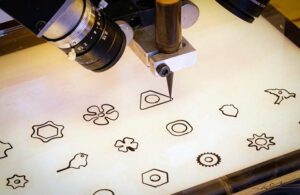
Two computer vision cameras monitor this 3D printer to detect errors and adjust in real time. [Photo courtesy of MIT]
An AI-enabled additive manufacturing system allowed a 3D printer to monitor and adjust material handling in real time, cutting down the trial-and-error process of learning how to print with new materials.
The technology could make it easier for engineers in medtech and other industries to use new materials in 3D printed products for special electrical or chemical properties, cutting down on the time and materials spent on trial-and-error. It could also help manufacturing equipment adjust to changes in the material or printing environment.
The MIT researchers behind the research project said it could have applications for manufacturing processes beyond 3D printing.
“This project is really the first demonstration of building a manufacturing system that uses machine learning to learn a complex control policy,” senior author Wojciech Matusik said in a news release. “If you have manufacturing machines that are more intelligent, they can adapt to the changing environment in the workplace in real-time to improve the yields or the accuracy of the system. You can squeeze more out of the machine.”
Matusik is a professor of electrical engineering and computer science at MIT and leads the Computational Design and Fabrication Group (CDFG) within the Computer Science and Artificial Intelligence Laboratory (CSAIL).
He and his fellow researchers developed a machine learning system that watches the 3D printing process with computer vision to identify and correct errors. The system used simulations to teach a neural network how to minimize error by adjusting 3D printing parameters.
Two cameras use light to determine the thickness of material as it’s laid down, processing the images to adjust the printer’s feed rate and direction.
“You can think of the vision system as a set of eyes watching the process in real-time,” said co-lead author Mike Foshey, a mechanical engineer and project manager in the CDFG.
“We were also able to design control policies that could control for different types of materials on-the-fly,” Foshey said. “So if you had a manufacturing process out in the field and you wanted to change the material, you wouldn’t have to revalidate the manufacturing process. You could just load the new material and the controller would automatically adjust
Future improvements to the system could include AI measurement and adjustment of material viscosity, modification for multiple materials being printed at the same time or multiple layers, and controllers for other manufacturing processes.
The researchers offer more details in their study, Closed-Loop Control of Direct Ink Writing via Reinforcement Learning, and in the video below.